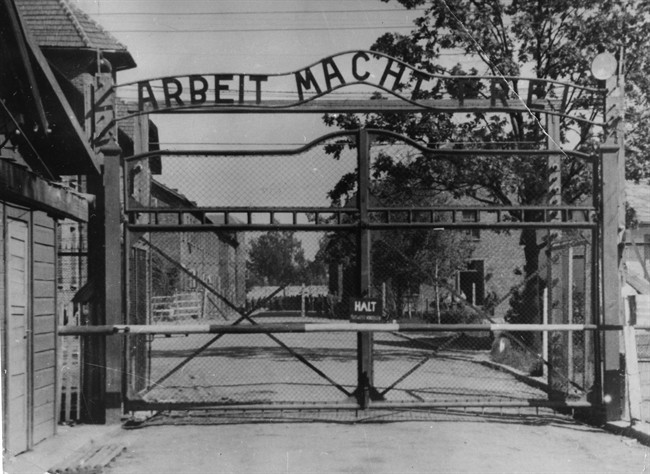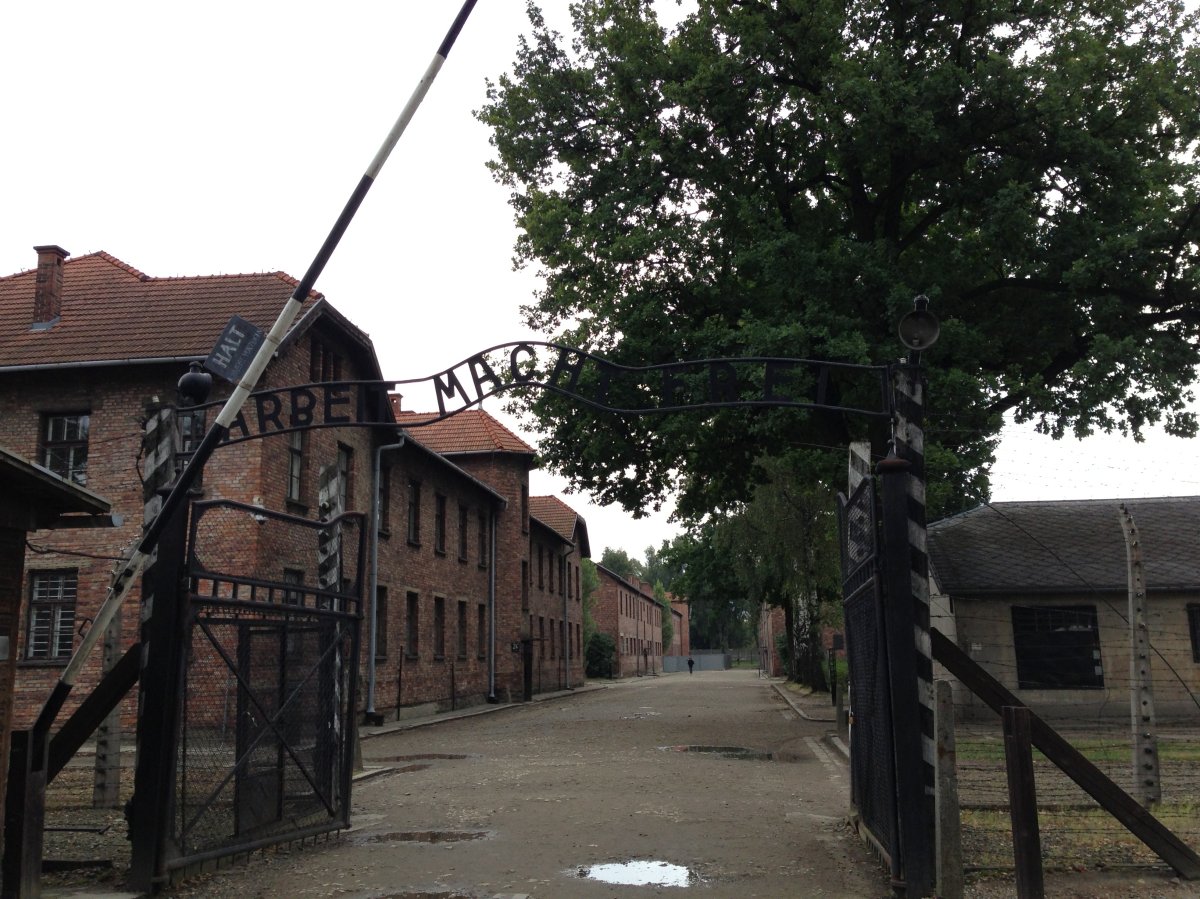I couldn’t shake the feeling of bile rising in my throat nor the hard knot that had taken root in my stomach as I looked up through the cold, pouring rain at the entrance to Auschwitz.

It seemed unremarkable in some ways, and judging by the teenage couple smiling and laughing as they snapped pictures, one without knowledge of history might be forgiven for thinking this was simply another tourist stop in Poland.
The now infamous words, “Arbeit Macht Frei, German for “Work makes you free,” scrolled above the entrance in wrought iron should certainly have been a sign that this was not simply a tourist destination, but a place of great sorrow and important lessons — a place of pilgrimage for so many who had lost so much during WWII.
I was about to enter Auschwitz, where an estimated 1.3 million people had been systematically and brutally exterminated during the Second World War.
It was also where members of my own family met their end.
My decision to visit was spurred by that knowledge and the stories I heard growing up. I knew my family’s history from those around me, who lived it and lived to tell about it.
Both my grandfather and grandmother survived against the odds.
My grandfather had spent years in a German work camp. He was one of only two people, out of 150, to survive illness and appalling conditions.
My grandmother was a courier in the Dutch underground taking great risks to her own life to aid the resistance.
At one point she was captured by the Germans, while her family hid a Jewish family in their home.
I walked through those gates at Auschwitz, trying to keep the sick feeling I had at bay.
I remembered what I already knew about that ugly chapter of history from textbooks and personal stories I’ve heard.
I had seen other places where genocide had occurred, most recently in March of this year the infamous Killing Fields and S-21 prison in Cambodia.
But not even that prepared me for what I would see as I walked through Auschwitz.
Maybe it was because of the personal connections to that chapter of history or the details preserved on the grounds so many years later, but I found myself viscerally effected.
Each building seemed to house more monstrosities than the next.
Some were used for medical experimentation, others for torture of an imaginable nature.
Others buildings had housed hundreds of prisoners starving, sick and living on top of each other in squalor.
As we ascended the steps of one particular building I was wholly unprepared for what I was about to see.
My guide asked me not to take any photos in the next room, but did not say why.
When we walked in, I understood.
I did all I could to keep the tears stinging my eyes from welling over and not to give in to the tumultuous feeling in my stomach.
Spanning the entire length of the room behind a glass wall was the overwhelming evidence of human lives snuffed out — almost two tonnes of human hair.
In another display across the room was a German SS uniform entirely made from that very same human hair.
As we made our way back downstairs and into the next building we passed by the couple from earlier. Their smiles now gone.
Their faces showed they were starting to grasp the magnitude of what had taken place there.
We continued into yet another room this time I was overwhelmed by the thousands, upon thousands of shoes rising up to the ceiling engulfing me on both sides of the room. Each pair belonging to someone.
Up another set of stairs, suitcases, personalized with the names and addresses of those who perished, hundreds piled high to the ceiling, frozen in time.
Maybe some of the people whose suitcases had been in that room had known what their fate would be, but many did not.
Many were brought to Auschwitz and later Birkenau, just down the road, believing they were starting a new life.
The Germans running the camp kept up that pretense as they separated out the weak, the old, the children and the ailing — sending them for a “shower”.
My guide, once again, did not prepare me for where we were about to go.
As we walked into the gas chambers I immediately felt an intense desire to get out — to run.
Inside the former gas chamber, an older woman and her daughter were lighting a candle and chanting in Hebrew as they wept.
They had come from Israel to pay their respects to friends and family who had perished there.
As we walked into the open air I took a deep breath, grateful that I could and trying not to think about what the people who had perished in that room had felt.
We kept walking as my guide and I got into a discussion about world leaders who had visited over the years.
We continued that discussion as we entered yet another room, this one containing the gas canisters that had been used to kill so many people there.
It occurred to me that despite the number of world leaders who had visited and had seen this place first hand, we were still to this day dealing with regimes that have been accused of using gas to exterminate people.
Throughout 2013, the headlines were constantly filled with reports of Bashar al-Assad’s regime using gas on Syrian people.
I thought of the images we had broadcast on our own newscast, appearing to show young children lifeless or gasping for breath after a chemical weapons attack.
Approaching the entrance to Birkenau just down the road, I felt the chilly air seep into my bones.
As we walked from building to building, we stopped at the train tracks to see one lone box car still on the rails — a monument to the people from all corners of Europe that survived the horrific conditions within those cars.
It was hard to fathom the sheer numbers of people who had once come into the camp on those rails to face incredible suffering and eventually death.
Those that survived were forever haunted by the inhumanity that transpired there.
As I boarded the bus back to Krakow, I tried to process what I had seen.
I tried to figure out what I would tell my 95-year-old grandmother.
I remembered her stories and those of many other people I had known who had lived through WWII.
I also started to think about the idealistic notion that war is never necessary, but in the face of evil and unimaginable suffering it was necessary for someone to step in.
For someone to fight for humanity and for freedom.
Canadian soldiers were among those who did just that.
My thoughts took me back to a bus driver I had as a 13-year-old girl living in The Netherlands.
I remember as if it was yesterday walking on the bus in my new Roots jacket, which my parents had bought for me on a recent trip back to Canada, proudly displaying the Canadian flag.
That driver never spoke, other than to grumble and complain. But that day his face lit up and in Dutch he asked if my brother and I were Canadian.
He smiled when I said we were and the next day as he picked us up at our door. He had flowers for my mother and a hug for both my brother and I as he said thank you.
He told us with tears in his eyes that Canadian soldiers had liberated his family from the Germans and that he would never forget that.
As we approach Remembrance Day here in Canada — nearly seven decades after the extermination camps were shutdown and the countries withering under the occupation of the Third Reich were liberated, I remember what Canadians sacrificed, so that more people didn’t perish.










Comments